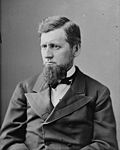Representative Party Years Cong Electoral history Location District created March 4, 1863 William B. Allison (Dubuque ) Republican March 4, 1863 – 38th 39th 40th 41st Elected in 1862 .Re-elected in 1864 .Re-elected in 1866 .Re-elected in 1868 .run for U.S. Senator . 1863–1873 [ data missing ] William G. Donnan (Independence ) Republican March 4, 1871 – 42nd 43rd Elected in 1870 .Re-elected in 1872 . 1873–1883 [ data missing ] Lucien L. Ainsworth (West Union ) Democratic March 4, 1875 – 44th Elected in 1874 . Theodore W. Burdick (Decorah ) Republican March 4, 1877 – 45th Elected in 1876 . Thomas Updegraff (McGregor ) Republican March 4, 1879 – 46th 47th Elected in 1878 .Re-elected in 1880 . 4th district and lost re-election there. David B. Henderson (Dubuque ) Republican March 4, 1883 – 48th 49th 50th 51st 52nd 53rd 54th 55th 56th 57th Elected in 1882 .Re-elected in 1884 .Re-elected in 1886 .Re-elected in 1888 .Re-elected in 1890 .Re-elected in 1892 .Re-elected in 1894 .Re-elected in 1896 .Re-elected in 1898 .Re-elected in 1900 . 1883–1887 Black Hawk , Bremer , Buchanan , Butler , Delaware , Dubuque , and Grundy counties1887–1933 Black Hawk , Bremer , Buchanan , Butler , Delaware , Dubuque , Franklin , Hardin , and Wright counties Benjamin P. Birdsall (Clarion ) Republican March 4, 1903 – 58th 59th 60th Elected in 1902 .Re-elected in 1904 .Re-elected in 1906 . Charles E. Pickett (Waterloo ) Republican March 4, 1909 – 61st 62nd Elected in 1908 .Re-elected in 1910 . Maurice Connolly (Dubuque ) Democratic March 4, 1913 – 63rd Elected in 1912 .run for U.S. Senator . Burton E. Sweet (Waverly ) Republican March 4, 1915 – 64th 65th 66th 67th Elected in 1914 .Re-elected in 1916 .Re-elected in 1918 .Re-elected in 1920 .run for U.S. Senator . Thomas J. B. Robinson (Hampton ) Republican March 4, 1923 – 68th 69th 70th 71st 72nd Elected in 1922 .Re-elected in 1924 .Re-elected in 1926 .Re-elected in 1928 .Re-elected in 1930 . Albert C. Willford (Waterloo ) Democratic March 4, 1933 – 73rd Elected in 1932 . 1933–1943 [ data missing ] John W. Gwynne (Waterloo ) Republican January 3, 1935 – 74th 75th 76th 77th 78th 79th 80th Elected in 1934 .Re-elected in 1936 .Re-elected in 1938 .Re-elected in 1940 .Re-elected in 1942 .Re-elected in 1944 .Re-elected in 1946 . 1943–1963 [ data missing ] Harold R. Gross (Waterloo ) Republican January 3, 1949 – 81st 82nd 83rd 84th 85th 86th 87th 88th 89th 90th 91st 92nd 93rd Elected in 1948 .Re-elected in 1950 .Re-elected in 1952 .Re-elected in 1954 .Re-elected in 1956 .Re-elected in 1958 .Re-elected in 1960 .Re-elected in 1962 .Re-elected in 1964 .Re-elected in 1966 .Re-elected in 1968 .Re-elected in 1970 .Re-elected in 1972 . 1963–1973 [ data missing ] 1973–1983 [ data missing ] Chuck Grassley (New Hartford ) Republican January 3, 1975 – 94th 95th 96th Elected in 1974 .Re-elected in 1976 .Re-elected in 1978 .run for U.S. Senator . T. Cooper Evans (Grundy Center ) Republican January 3, 1981 – 97th 98th 99th Elected in 1980 .Re-elected in 1982 .Re-elected in 1984 . 1983–1993 [ data missing ] David R. Nagle (Cedar Rapids ) Democratic January 3, 1987 – 100th 101st 102nd Elected in 1986 .Re-elected in 1988 .Re-elected in 1990 . 2nd district and lost re-election. Jim R. Lightfoot (Shenandoah ) Republican January 3, 1993 – 103rd 104th Redistricted from the 5th district and re-elected in 1992 .Re-elected in 1994 .run for U.S. Senator . 1993–2003 [ data missing ] Leonard Boswell (Des Moines ) Democratic January 3, 1997 – 105th 106th 107th 108th 109th 110th 111th 112th Elected in 1996 .Re-elected in 1998 .Re-elected in 2000 .Re-elected in 2002 .Re-elected in 2004 .Re-elected in 2006 .Re-elected in 2008 .Re-elected in 2010 . 2003–2013 Tom Latham (Clive ) Republican January 3, 2013 – 113th Redistricted from the 4th district and re-elected in 2012 . 2013–2023 David Young (Van Meter ) Republican January 3, 2015 – 114th 115th Elected in 2014 .Re-elected in 2016 . Cindy Axne (West Des Moines ) Democratic January 3, 2019 – 116th 117th Elected in 2018 .Re-elected in 2020 . Zach Nunn (Bondurant ) Republican January 3, 2023 – 118th 119th Elected in 2022 .Re-elected in 2024 . 2023–present : 





























